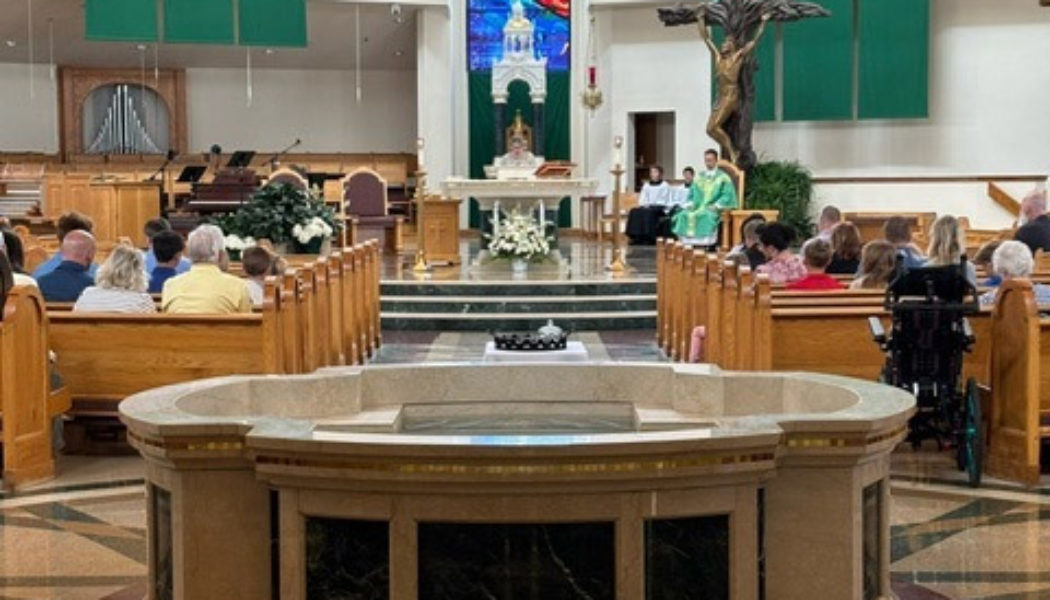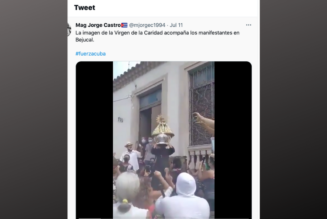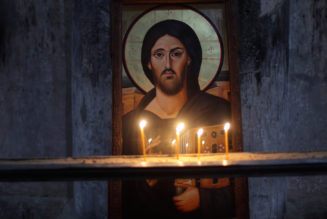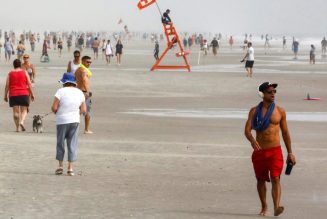St. Vincent de Paul parish in Fort Wayne, Indiana, has the most highly attended sensory-friendly Mass I know of. They have 400-700 people on an average Sunday. They have been going for just under 3 years and have grown big mainly through word of mouth. I interviewed Sarah Olson, one of the organizers, about it. Before the interview, I will include a bit of background. This is the second in my series of three parishes where a sensory-friendly Mass or space has been going on for a while. (First and third in the series.)
Background on Sensory-Friendly Mass
Not long after they began, the diocesan paper covered the sensory-friendly Mass:

The sensory-friendly Mass addresses some of those reactions, and the practice is growing within the Diocese of Fort Wayne-South Bend. St. Vincent de Paul Parish in Fort Wayne recently began hosting a special Sunday afternoon Mass dedicated to meeting this need.
Father Jay Horning is one of the parish’s parochial vicars and was appointed interim pastor while Father Daniel Scheidt went on sabbatical during the fall. Father Horning had already been considering reinstituting a Sunday afternoon Mass when parishioner Sarah Olson approached him about the possibility of a sensory-friendly Mass, so he chose to “give it a distinct purpose,” he stated.
Olson is the mother of nine children, one of whom – John – has autism and two others who were born deaf and now have cochlear implants. “We’ve always been on this journey, this search for how we can have a big family, go to Mass together and have our son with us and our other children and be part of the Mass,” she said…
The sensory-friendly Mass is not only meant for those with disorders like autism or Tourette’s syndrome, but for anyone who has need of it. People in wheelchairs, older people with restricted driving hours and families with young children can find a home at the 1:30 p.m. Mass. Attendees are also encouraged to participate in whatever capacity they are able. Olson would love to see John serve at that Mass with the aid of his older brother.
You can read more on the diocesan paper’s website or my prior post about it.
Interview with Sarah Olson in 2024
When I called the parish about this Mass to ask who to speak with, they connected me to Sarah Olson who is a mother who has attended the sensory-friendly Mass from the beginning. I conducted this interview over the phone. It has slight editing for clarity and brevity: I ran it by Mrs. Olson before publishing.
Fr. Matthew P. Schneider, LC: Can you tell me about how the sensory-friendly Mass has grown?
Sarah Olson: So, when we first started, it was about 30 people, with our family of 12 being a large portion. We went from 30 people to about 400 to 700, depending on the weekend. We see a lot of families with children and adults with disabilities, cognitive or physical, both the seen and unseen disabilities. We have had many middle-aged women who have come and said that they appreciate it: they may have emotional anxiety or similar. They really appreciate the [sensory-friendly] Mass.
Many elderly, who, for whatever reason, whether it is due to medical issues or difficulty being able to get around in wheelchairs, we can accommodate them. For those who have difficulty making into up to communion, even if they are back in the gathering space, myself or one of the other extraordinary ministers of the Eucharist, will bring Communion back to them.
By no means does everyone who attends have a disability or “special need” but this mass does fill a specific need for those who attend. The mass is here for everyone.
Me: That’s wonderful. I keep a directory on my own website, and so I’m in contact with many throughout the country, and I can tell you 400-700 is probably the biggest one I’ve heard of.
Me: How has the word gotten out? When I see it as one of the biggest ones in the country, that’s what I want to think about to try to help other parishes doing similar things in a different city.
Sarah: I think word of mouth. We do have some from outside of our own parish who attend regularly. It is also in our bulletin, but aside from that, most people just have heard from other people. Allison Sturm, who works for the diocese, has also let people know who may find the sensory mass is right for them or their families.
Me: What do you do to make it sensory-friendly? Do you turn down the lights? Do you use the same songs every Sunday, or what do you do differently in the sensory-friendly Mass from other Masses at the parish, as it varies a little from place to place?
Sarah: The lights are turned down low. There is still light coming in from the windows, too. The sound is turned off on the side perimeter, so it is only on down the main aisle sections. We hand out a brochure with a diagram showing where it is quiet and where there is louder sound. There is no music. There is no incense. The Mass tends to be right at 35-40 minutes with a shortened homily.
Me: Those are the main things? Has how it helped changed since it was covered in Today’s Catholic [diocesan paper]?
Sarah: We have not changed much. We have taken some suggestions like bringing in noise-canceling headphones; we beefed up our announcement at the beginning before mass starts. When we first started, the priest would walk in and briefly explain the sensory-friendly Mass: mention that if you saw people making sounds or standing when they should be sitting or rocking or similar, this is all joyful, it is joyful noise, and nobody is being disrespectful. We played with the announcement before Mass to include details of where the sounds are different or where the gluten-free hosts are, so that we can make sure we assist in any way we can. That announcement and adding the brochure (which details what the sensory is and what you can expect) are the only things that we have really altered since the beginning.
Me: Tell me about your family’s experience.
Sarah: When we started out, I envisioned it going one way and it went another more beautiful way. It was hard to go Mass with [my son] with autism. He really struggled; he would be loud; he would throw things; people would look; he would get aggressive at times. So, my husband and I started going to separate Masses. We were going to the 7 or a 9am Mass. So, the 1:30pm Sensory Mass was a really different time for us, but it has been beautiful for my family because it makes the mass the center of our Sunday. It slows us down in the morning, and then we go to Mass midday. The Mass itself with the Eucharist as the center, it is the focus.
I have two other kiddos who are deaf. It has been really wonderful for the two of them, too. They can get up closer and can be part of the mass if they want. They help greet, pass out the brochures and assist with the collection baskets.
Me: Have any people with various disabilities who need to go to this Mass started serving in any ministries?
Sarah: Yes, we have children with different disabilities who help with greeting. Some of the most joyful greeters! We also have some who assist with the collection baskets and carrying up the gifts. Many of the children are so excited to be part of the mass. They are such great helpers. There was a young man, who is a server, who offered to serve at the sensory mass, this has allowed my son with autism to go alongside him and be a server, too. This has been such a blessing and joy as his mother to watch him serve in this ministry. It is a beautiful opportunity for my son (and hopefully others if they wish) that he may not have otherwise had, if not for this sensory mass, this young man offering to serve, and the support of the parish.
We have heard from many people who said they enjoy the Mass and enjoy watching all the children and families participate.
Me: What has been the relationship with parish leadership regarding this Mass?
Sarah: Our pastor and the other priests have been so supportive. I think we have come back to the table and met with the priest and parish staff a couple times to see what is going well and what we can do better. Like the first year, we did not have the sensory mass for Christmas or Easter and a bit of the summer was taken off with First Communions and other things. From what I was told some people called expressing they missed the sensory mass. The next year we had it all through the summer months too. Then this year was the first year we had the 1:30pm sensory-friendly Mass on Easter Sunday. The parish and priests have been so supportive, and we know it is not going to go anywhere. From what I have been told, they have received a lot of positive feedback about how much people enjoy it and how much it has helped individuals and families. I know the success of the mass is due to the immense support of our pastor and the entire parish staff and wanting to keep the intentionality of the sensory mass what it is.
Conclusion
St. Vincent de Paul in Fort Wayne seems like the biggest success story with a sensory-friendly Mass. I hope that many other parishes can become like that where there is a Mass for all those needing a low-sensory environment, the space to stim, etc. I suspect most cities have enough people to similarly fill a sensory-friendly Mass like this. I was kind of expecting some extraordinary action at the parish to get so many at such a Mass by Mrs. Olson shows it is just doing the simple things well. Let’s learn from this parish.
Note: I wanted to cover parishes that have had sensory friendly Masses or spaces for a while, as usually diocesan papers only cover them when they are new. I was commissioned to write a chapter on autism-accessible Masses in a book on disability theology with Word on Fire coming out later this year. For this chapter, I wanted to have such testimonies, which led me to interviewing three people where a few lines will be in the chapter, but the longer text will be here on my blog.










